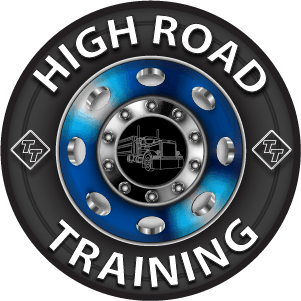Note: Your are not logged in. We can not keep your scores or track your progress unless you Register and Log In
6.4.2 – Uncoupling Tractor-Semitrailers
The following steps will help you to uncouple safely.
Step 1: Position Rig
- Make sure surface of parking area can support weight of trailer.
- Have tractor lined up with the trailer. (Pulling out at an angle can damage landing gear.)
Step 2: Ease Pressure on Locking Jaws
- Shut off trailer air supply to lock trailer brakes.
- Ease pressure on fifth-wheel locking jaws by backing up gently. (This will help you release the fifth-wheel locking lever.)
- Put parking brakes on while tractor is pushing against the kingpin. (This will hold rig with pressure off the locking jaws.)
Step 3: Chock Trailer Wheels
- Chock the trailer wheels if the trailer does not have spring brakes or if you are not sure. (The air could leak out of the trailer air tank, releasing its emergency brakes. Without chocks, the trailer could move.)
Step 4: Lower the Landing Gear
- If trailer is empty, lower the landing gear until it makes firm contact with the ground.
-
If trailer is loaded, after the landing gear makes firm contact with the ground, turn crank in low gear a few extra turns. This will lift some weight off the tractor. (Do not lift trailer off the fifth wheel.) This will:
- Make it easier to unlatch fifth wheel.
- Make it easier to couple next time.
Step 5: Disconnect Air Lines and Electrical Cable
- Disconnect air lines from trailer. Connect air line glad hands to dummy couplers at back of cab or couple them together.
- Hang electrical cable with plug down to prevent moisture from entering it.
- Make sure lines are supported so they will not be damaged while driving the tractor.
Step 6: Unlock Fifth Wheel
- Raise the release handle lock.
- Pull the release handle to “open” position.
- Keep legs and feet clear of the rear tractor wheels to avoid serious injury in case the vehicle moves.
Step 7: Pull Tractor Partially Clear of Trailer
- Pull tractor forward until fifth wheel comes out from under the trailer.
- Stop with tractor frame under trailer (prevents trailer from falling to ground if landing gear should collapse or sink).
Step 8: Secure Tractor
- Apply parking brake.
- Place transmission in neutral.
Step 9: Inspect Trailer Supports
- Make sure ground is supporting trailer.
- Make sure landing gear is not damaged.
Step 10: Pull Tractor Clear of Trailer
- Release parking brakes.
- Check the area and drive tractor forward until it clears.
Multiple-Choice Questions:
After disconnecting the tractor from the trailer, what should you do when pulling away from the trailer?
- Pump the brakes several times to make sure air isn't leaking
- Crank the landing gear up so that there's at least two inches between the 5th wheel and the trailer apron
- Make sure the air lines are reversed
- Stop with tractor frame under trailer (prevents trailer from falling to ground if landing gear should collapse or sink)
Step 7: Pull Tractor Partially Clear of Trailer
- Pull tractor forward until fifth wheel comes out from under the trailer.
- Stop with tractor frame under trailer (prevents trailer from falling to ground if landing gear should collapse or sink).
This question will not be on the test, but it's very important in real life. After you have disconnected from the trailer, pull forward but do not pull completely out from under the trailer. Keep the frame of the tractor under the trailer, get out to check that the landing gear is on solid ground, then pull out the rest of the way.
Many trailers have sunk in soft gravel or mud deep enough that it took a lot of cranking on the landing gear or even a tow truck to life the trailer high enough to get a tractor under it again.
Complete!
You can Return To The Table Of Contents







 TT On Facebook
TT On Facebook